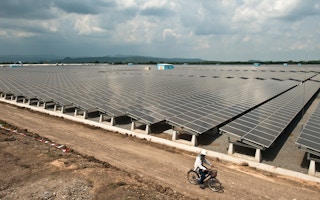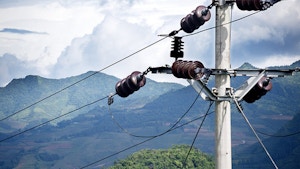Beyond their green credentials, solar power projects have often been marketed as cheap, modular and quick to install, compared to fossil fuel alternatives.
A utility-scale solar farm could be built in about a year, several times faster than a coal plant. New solar and wind projects could also be delivering electricity cheaper than existing nuclear and fossil fuel plants, according to a financial report last year.
This bodes well for Southeast Asia, which is just starting to dip its toes into wind and solar power. The regional bloc, the Association of Southeast Asian Nations, wants to get 23 per cent of its power from renewables by 2025, up from 9 per cent in 2019.
Electricity demand in the region is growing at 6 per cent yearly – one of the fastest rates in the world – in line with rapid economic growth, industrialisation and growing populations.
With an increase in renewable energy generation, power grids must evolve to accommodate higher levels of complexity to cope with readily dispatchable sources of electricity as well as from more variable ones such as solar and wind.
Experts forecast a bumpy outlook if the right infrastructure is not in place to support variable renewable energy sources.
Muralidharan Ramakrishnan, the head of South and Southeast Asia energy and utilities at credit rating agency Fitch Ratings, pointed to the experience of countries which have started their renewables drive earlier.
In 2015, China’s wind power development spree saw it own about a third of the world’s wind generation capacity. But that year, 15 per cent of electricity produced from China’s wind farms went to waste. The figure reached nearly 40 per cent in windy Gansu province. In all, US$3 billion dollars worth of energy was wasted.
Beyond stiff competition from subsidised coal power, the lack of suitable long-range transmission lines and energy storage facilities contributed to the dumping of excess wind power. When supply exceeded demand — for example, when few people were using electrical appliances in the midday but the wind was blowing strong — operators were told to disconnect.
It was a similar situation in India then, with the national grid only able to support about 5 per cent of renewables, resulting in frequent disconnections from solar power farms.
The fast pace at which solar and wind projects can be completed means that corresponding transmission infrastructure, which takes years to build, may not be ready in time, Ramakrishnan said.
“That said, the situation [in China and India] has improved significantly over the past three to four years, supported by strengthening of grid infrastructure,” added Ramakrishnan.
Southeast Asia may experience similar growing pains as it adopts more renewable energy. A report by accounting firm PwC last year said advanced grid infrastructure is still not available in countries like Brunei, Cambodia and Laos.
In recent years, some solar power projects in Vietnam had to reportedly dump 80 per cent of their generated electricity. While the country’s solar power capacity grew rapidly in 2019 and 2020, the power grids couldn’t keep up with the imbalances between peak supply – when the sun is shining, and peak demand – when households generally switch on larger appliances in the evening.
In a recent report by engineering consultancy Black & Veatch that polled Asia’s electricity industry leaders, over a third said integrating renewable energy is one of their most challenging issues. Over 30 per cent consider the lack of energy storage and reliable transmission networks as threats to providing reliable service.
“
There is a clear need to increase awareness among governments, investors and other public stakeholders around the role of transmission and grid management on improving the effectiveness of renewable integration
Narsingh Chaudhary, executive vice president and managing director, Black & Veatch Asia Pacific
“There is a clear need to increase awareness among governments, investors and other public stakeholders around the role of transmission and grid management on improving the effectiveness of renewable integration and achieving a successful energy transition,” said Narsingh Chaudhary, executive vice president and managing director of Black & Veatch Asia Pacific.
Governments need to take lead
Grid upgrades to support wind and solar power are expected to cost Southeast Asia US$1.2 trillion between 2019 and 2040.
The money accounts for making sure grids can handle high supply variability, as well as systems that can adjust electricity prices in real time to better match power demand and supply.
Such systems were less important when the power sector was dominated by fossil fuels, since plant operators could adjust fuel input in response to demand changes.
New, longer transmission lines may be needed as where the sun shines and wind blows may be far away from power-hungry urban areas.
Experts say such issues need to be addressed by national governments.
“In most countries in Southeast Asia, state grids are unable to keep pace with the rapid growth of distributed generation due to a lack of funds or coordinated planning,” Chaudhary said.
Daniel Morris, the clean energy lead at green finance initiative Climate Investment Funds (CIF), added that there’s public good considerations when planning for electricity networks.
“You get into issues such as zoning, like where do grids go, are you displacing people, are you affecting people with their development?” Morris said. “Leaving that to the private sector by itself can result in some issues that are maybe not beneficial for the larger goal of trying to support the nation’s growth while getting on a zero carbon path.”
The CIF currently funds grid modernisation and energy storage initiatives in Ukraine, Fiji, Colombia, Kenya, and Mali. Five other countries, including Indonesia, are on the waitlist.
Some countries in Southeast Asia are starting to recognise the importance of centrally-led grid development. Vietnam’s power development plan for this decade, PDP8, identified grid development as a key priority. Indonesia’s latest five-year energy plan also describes the deployment of “smart grids” to better integrate renewable energy.
Renewable energy could also be better managed through the temporary storage of excess power. Batteries with hours-long capacity is the current norm; there are also efforts to store excess electricity as hydrogen fuel, which can be shelved for months.
The European Union, widely seen as a leader in renewables, had 40 gigawatts (GW) of storage capacity in 2020. Renewables contributed 21 per cent to its energy mix.
Asia Pacific had a storage capacity of less than 4 GW in the same year, and most of the capacity was found outside Southeast Asia, in countries such as Australia, China, Japan and South Korea. The region only got 7 per cent of its energy from renewables in 2018.
“Case-by-case, location-by-location, answers will vary and countries need to draw from a different mix of technologies, some that are affordable today and others that will become more common and effective as policies are updated and costs decline,” Chaudhary said.
Watch the weather
Increasingly bad weather associated with a warming planet could scupper efforts to improve Southeast Asia’s electricity infrastructure. The latest Intergovernmental Panel on Climate Change report on climate science observes stronger cyclones and predicts higher floods for the Southeast Asia region.
Late last year, Typhoon Rai left five million people in the Philippines without electricity. Similar blackouts have occurred following major typhoons in the past decade.
“We’ve reached a point where you can’t ignore climate risk, and in fact, you probably pose more risk to plans and investments by ignoring it,” Morris said.
Existing research points to solutions such as building transmission lines underground to protect against typhoons, and making grids more modular to prevent widespread outages. Microgrids could also serve as a potential solution for the electrification of remote areas, bypassing the prohibitive cost of grid extensions.
The Intergovernmental Panel on Climate Change also recommends keeping design standards for energy assets on par with current and projected climate change.











